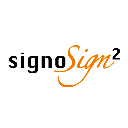The advanced electronic signature: definition, differences and application
The advanced electronic signature is a topic that is increasingly present in companies today. It is not a question of digitally validating a document or scanning a handwritten signature, but of implementing a process that guarantees compliance with regulations.
The European regulations on electronic identification define 3 types of electronic signatures depending on the level of commitment required: simple, advanced and qualified.
In this article, we will focus on the advanced electronic signature. Discover what it means, its differences with the other types of signatures, when to use it and how to create it.
What is an electronic signature?
Regulation
As we said at the beginning, this is not a simple digital equivalent of a handwritten signature: it is not enough to sign on a touch screen or scan a signature.
The legal value of the electronic signature is often equated with the value of the handwritten signature. However, not all digital signatures have the same effect, as they depend on the form: They are either simple, advanced or qualified signatures.
Electronic signatures are regulated in the EU by Regulation (EU) No. 910/2014 of the European Parliament and of the Council of July 23, 2014 on electronic identification and trust services for electronic transactions. In Germany, qualified and advanced signatures have been defined in the Signature Act (SigG) since 2001. They were only replaced by the eIDAS Regulation in 2016.
The EU Regulation, also known as the eIDAS Regulation (acronym for electronic IDentification, Authentication and Trust Services), brings together all regulations for electronic identification with a single objective:
Strengthening the internal market through high safety standards within the European Union.
Definition
An electronic signature is a sequence of characters that is attached to a document to link a signatory to the document. This process uses cryptology to ensure its security.
The content of the document is systematically archived and secured as soon as the digital signature is affixed to the document. A signed document can therefore no longer be altered.
Differences between simple and qualified signatures
Electronic signatures are classified according to their level of authenticity. Let's see how and why.
What is a simple signature?
The definition of a simple electronic signature is quite broad and therefore open to interpretation. A simple signature can therefore be found in various forms: a scanned handwritten signature, a ticked box on a website, a card code at an ATM, etc.
This solution does not clearly identify the signatory; however, 80 to 90% of use cases are simple electronic signatures! The simple electronic signature is strengthened thanks to providers who add an authentication step, and can therefore be given greater legal value.
What is a qualified signature?
Article 25-2 of the eIDAS Regulation stipulates that the legal effect of a qualified electronic signature is equivalent to a handwritten signature .
It is basically an advanced electronic signature that is based on a digital certificate for electronic signatures and is created by a qualified device.
Unlike advanced electronic signatures, which do not explicitly require the use of a digital certificate, the definition of a qualified signature requires the use of a qualified certificate, which according to the regulations can only be obtained through an entity that is also certified according to ISO 15408.
It is also the most difficult level of certification requirements for signatures, the purpose of which is to guarantee the integrity and origin of the data. EU member states must recognize the validity of a qualified electronic signature.
© eggs.de
Advanced electronic signature: definition and requirements
In contrast to simple electronic signatures, advanced electronic signatures must meet stricter criteria for identity verification and therefore have a higher level of security as they are based on a public key infrastructure. According to the eIDAS Regulation , the advanced signature must
- Be uniquely and clearly linked to its signatory;
- enable the official identification of the signatory;
- be created by devices available to the signatory, such as their phone or computer;
- ensure that the act to be signed cannot be subsequently altered.
Advanced electronic signature: application
When it comes to ensuring a high level of security and confidentiality, the advanced signature is an excellent option. For companies or individuals who need to request signatures at a distance frequently, the qualified signature is not highly recommended as it requires specific devices and certificates. It is usually limited to transactions with public administrations, such as the tax office or social security.
In this sense, the advanced electronic signature is a good option as it offers the perfect balance between security and ease of use.
This signature is recommended for important financial transactions or when signing documents that represent important legal issues, such as contracts and official documents.
Use cases for advanced signatures:
- Sales contracts in the real estate sector,
- Agreements for opening bank accounts,
- Electronic invoices for public administration,
- Certain banking and insurance products (savings, life insurance, etc.)
How can you sign electronically?
Depending on whether it is a simple, advanced or qualified signature, you must use a secure solution. There are various providers. With appvizer, we would like to introduce you to two tools that allow you to manage all types of signatures in an intuitive and secure way from a single platform.
signoSign/2
signoSign/2 from signotec enables the digitization of signatures thanks to a secure, intuitive and simple solution.
signoSign/2 functions:
- Signing of PDF documents,
- Compliance with EU eIDAS regulation and ISO standard,
- Automated further processing of documents,
- Legally compliant advanced electronic signatures.

signoSign/2
Yousign
Yousign is a simple and flexible solution for electronic signatures that offers numerous security and confidentiality guarantees for simple and advanced electronic signatures.
Yousign functions:
- eIDAS, ETSI, LSTI & ANSSI certified,
- Electronic safe for secure digital storage,
- Easy adaptation to your company, whether startup, SME or large corporation,
- Strong authentication for the legal validity of signatures, whether simple or advanced signature (security codes via SMS).

Yousign
Fulfill your obligations with just a few clicks
The electronic signature is more than just a digital transformation trend. The use of digital signatures is clearly defined within the framework of the European Union. Electronic signature management systems comply with the requirements and provisions of the regulation.
They offer services that are easy to implement and guarantee the legal value of electronic documents and signed data.
What about you? Do you already know who you will rely on for your electronic signatures?
Article translated from German